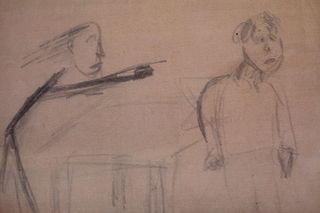boy on tree house drawing
That child's drawing of a house, tree, or person may represent more than an element of the refrigerator-as-art-gallery. It may predict a child's intelligence later in life. A child's intelligence at 14 years of age may be predicted by how well he or she draws at age 4 (Arden, 2014). Some 7,000 U.S. children at the age of 4 were asked to draw a child. Figures were scored on the presence and correct quantity of human features. The more features pictured, the higher the score. Seven years later, the same children were asked to take an intelligence test. The results from the intelligence test were then related to the results of the drawing test. A pattern was found, suggesting that drawings at 4 years of age could predict later intelligence (Arden, 2014).
Drawings tell a lot about what we are thinking. The patterns we draw on paper can lead to the discovery of our biases, feelings, relationships, family, home life, self-esteem, and even intelligence. They are mirrors to our minds (Buck, 1984). For some pediatricians, it is standard practice to ask children to draw. When children draw, it helps to heal them. It shifts their mental state from stress to serenity. It can inspire a conversation between the pediatrician and child. It is far easier, for example, for a child to talk about his or her drawing than about himself or his feelings (Malchiodi, 2009).
Close your eyes. Picture a scientist in your mind's eye. What is the scientist wearing and holding? Describe the facial features and hair. What kinds of equipment are in the picture? Now, open your eyes, and, quickly draw the scientist! After you have finished, ask yourself, is the scientist male and white? Does the scientist have wild hair and wear glasses? Is the scientist wearing a lab coat and working in a laboratory surrounded by test tubes, beakers, a microscope, etc. Were you imaging Albert Einstein?

Mad Scientist
Source: Wikimedia Commons
If you answered "yes" to most of these questions, your mental image agrees with the visual pattern most people picture when they draw a scientist (Symington, 2006). What is wrong with this picture? The answer is that it stereotypes scientists who are not necessarily male, white, or work in a laboratory. It confirms what two anthropologists confirmed more than 50 years ago when they tested how more than 3,500 high school students pictured a scientist. The most popular image was a study in white and maleness. By the fifth grade, the stereotype of a scientist is already present and persists through adulthood (Finson, Drawing a Scientist: What We Do and Do Not Know After Fifty Years of Drawings, 2014).
Children's art, according to experts, is filled with insights into kids' minds if you know what to look for (Buck, 1984). Therapists use a standard technique to discover how children perceive themselves in the world. It is called draw a house-tree- person (Buck, 1984). It is the projective House-Tree-Person test in which children are asked to draw these three items. The house mirrors the child's home life and family relationships; the tree reflects relationships that the child experiences within his or her environment; and, the person echoes how the child feels about himself. When children reach six years of age, this is the sweet spot when their drawings really matter. Visual patterns are clues to their relationship to family and friends, and the environment and the image that children have of themselves (Dewar, 2014).

Happy Family Drawing
Source: Wikimedia Commons
When, for example, kids draw family members holding hands, it is a good sign of a friendly relationship among the family members. Drawings created with bright colors and happy faces suggest a sense of belonging. When parents are going through conflicts of some sort, the kids will draw the parents far apart. Kids may draw themselves distant from their parents or much smaller relative to their others in the family when there is chaos in the home ranging from clutter to crowding. A child who has been abused might draw an abuser with bigger hands than normal (How to Analyze a Child's Drawings, 2013).

Family Conflict
Source: Robert Barkman
When kid's drawings were first studied to identify patterns in child development in the 1880s, it was thought that cultural differences mattered little. Because the social world of friends and families is shaped by the culture of the child, we would, however, expect drawings to reflect that. They, in fact, do. Drawings from three different cultures; German upper-class families, Cameroon farming families, and Ankara, Turkey urban middle-class families were compared in a recent study (Gernhardt, 2013).
Patterns differed in the depiction of selves and arrangement of family members in several ways. Cameroon children drew families that included members other than their father or mother. The father figure was, in fact, mostly absent. This is consistent with Cameroon culture that is characterized by an extended family of multiple caretakers and family members. This contrasts with Ankara and German drawings that show only the father and mother. Children draw themselves next to their mother and father who are the principal caretakers. In Cameroon, it takes a village. Cameroon children often draw themselves next to non-relatives. Ankara and German children often draw their figures smiling. Cameroon children do not. They are taught to control their emotions and stay emotionally neutral. It is not surprising that Cameroon children also drew the fewest facial features. It was equally interesting that Ankara children were the only group that drew eyebrows on their figures. It could be because eyebrows are important in the Turkey culture to communicate non-verbally. Tipping your head forward means "yes" but lifting your head backwards and raising your eyebrows means "no"(Gernhardt, 2013). By taking advantage of children's love to draw, we can learn much about their inner world from the visual patterns they place on paper.
References
Arden, R. (2014, August 20). Genes Influence Young Children's Human Figure Drawings and Their Association With Intelligence a Decade Later. Retrieved from Psychological Science: http://pss.sagepub.com/content/early/2014/08/19/0956797614540686.full
Buck, J., (1948) The H-T-P Technique, A Qualitative and Quantitative Scoring Method. Journal of Clinical Psychology Monograph Supplement No. 5, 1-120
Buck, J. (1984). House-Tree-Person Technique. Retrieved from Test Critiques: http://www.killianphd.com/Portals/0/House-Tree-Person%20Technique.pdf
Malchiodi, C. (2009, July 15). Helping Children Draw Out Their Traumas. Retrieved from Psychology Today: https://www.psychologytoday.com/blog/arts-and-health/200907/helping-chi…
Symington, D. (2006, July 7). The 'Draw a Scientist Test': interpreting the data. Retrieved from Research in Science and Technological Education: http://www.tandfonline.com/doi/abs/10.1080/0263514900080107?journalCode…;
Finson, K. (2014, September 12). Drawing a Scientist: What We Do and Do Not Know After Fifty Years of Drawings. Retrieved from Researchgate: https://www.researchgate.net/publication/229447487 Drawing a Scientist What We Do and Do Not Know After Fifty Years of Drawings
Dewar, G. (2014, December 23). What kids' drawings can reveal about their lives at home. Retrieved from Baby Center: http://blogs.babycenter.com/mom_stories/kids-drawings-reveal-clues-1223…
Gernhardt, A. (2013, February 20). This Is My Family":Differences in Children's Family Drawings Across Cultures. Retrieved from Journal of Cross-Cultural Psychology: http://jcc.sagepub.com/content/early/2013/02/20/0022022113478658
Source: https://www.psychologytoday.com/us/blog/singular-perspective/201808/visual-patterns-draw-house-tree-person
0 Response to "boy on tree house drawing"
Post a Comment